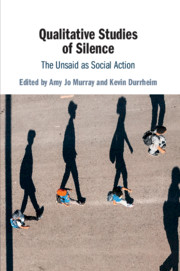Book contents
- Qualitative Studies of Silence
- Qualitative Studies of Silence
- Copyright page
- Dedication
- Contents
- Figures
- Contributors
- Acknowledgments
- Introduction: A Turn to Silence
- 1 Literal and Metaphorical Silences in Rhetoric: Examples from the Celebration of the 1974 Revolution in the Portuguese Parliament
- 2 Seeing Silenced Agendas in Medical Interaction: A Conversation Analytic Case Study
- 3 Listening to the Sound of Silence: Methodological Reflections on Studying the Unsaid
- 4 Social Silences: Conducting Ethnographic Research on Racism in the Americas
- 5 Intimate Silences and Inequality: Noticing the Unsaid through Triangulation
- 6 Silence in the Court: Moral Exclusion at the Intersection of Disability, Race, Sexuality, and Methodology
- 7 Silencing Self and Other through Autobiographical Narratives
- 8 Gendering the Unsaid and the Unsayable
- 9 The Language Ideology of Silence and Silencing in Public Discourse
- 10 Propaganda by Omission: The Case of Topical Silence
- 11 Silencing Whistleblowers
- 12 Between Sound and Silence: The Inaudible and the Unsayable in the History of the First World War
- 13 Affect and the Unsaid: Silences, Impasses, and Testimonies to Trauma
- 14 The Unsaid and the Unheard
- 15 Conclusion: Topographies of the Said and Unsaid
- Index
- References
5 - Intimate Silences and Inequality: Noticing the Unsaid through Triangulation
Published online by Cambridge University Press: 30 June 2019
- Qualitative Studies of Silence
- Qualitative Studies of Silence
- Copyright page
- Dedication
- Contents
- Figures
- Contributors
- Acknowledgments
- Introduction: A Turn to Silence
- 1 Literal and Metaphorical Silences in Rhetoric: Examples from the Celebration of the 1974 Revolution in the Portuguese Parliament
- 2 Seeing Silenced Agendas in Medical Interaction: A Conversation Analytic Case Study
- 3 Listening to the Sound of Silence: Methodological Reflections on Studying the Unsaid
- 4 Social Silences: Conducting Ethnographic Research on Racism in the Americas
- 5 Intimate Silences and Inequality: Noticing the Unsaid through Triangulation
- 6 Silence in the Court: Moral Exclusion at the Intersection of Disability, Race, Sexuality, and Methodology
- 7 Silencing Self and Other through Autobiographical Narratives
- 8 Gendering the Unsaid and the Unsayable
- 9 The Language Ideology of Silence and Silencing in Public Discourse
- 10 Propaganda by Omission: The Case of Topical Silence
- 11 Silencing Whistleblowers
- 12 Between Sound and Silence: The Inaudible and the Unsayable in the History of the First World War
- 13 Affect and the Unsaid: Silences, Impasses, and Testimonies to Trauma
- 14 The Unsaid and the Unheard
- 15 Conclusion: Topographies of the Said and Unsaid
- Index
- References
Summary
Silence permeates intimate spaces and intimate relationships. Such intimate silences shape social action, which can establish and maintain fundamental inequalities. The unsaid can be difficult to identify, especially in such contexts. However, by showing how we “tiptoe” around particular topics, a convincing case for the unsaid can be made. Using two case studies, we show how triangulation can be used to make the unsaid noticeable. The first case study is situated in post-apartheid South African paid domestic labor, where dyadic research was used to reveal silences around the topics of black sexuality, male visitors, and employer monitoring. These silences work to maintain privileged white control over intimate black activities. The second case study occurs in the undocumented student movement in the United States, where a comparison between public utterances and individual interviews revealed an absence of talk around intimate partner violence within the public discourses of undocumented students. This absence works to keep inequalities around ongoing domestic violence among undocumented immigrants invisible and unaddressed. In both cases, it was only through multimethod research that the absences and dissonances across the data sets were noticed, allowing for new understandings of the issues and their fundamental inequalities.
Keywords
- Type
- Chapter
- Information
- Qualitative Studies of SilenceThe Unsaid as Social Action, pp. 89 - 106Publisher: Cambridge University PressPrint publication year: 2019
References
- 3
- Cited by

